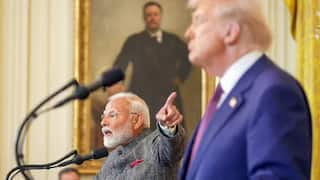RBI In Talks With Government For Privatisation Of PSBs, India To Have Four Types Of Banks
The RBI governor said that the process will go forward soon and the digital payers will play an important role in the four sets of banking. The governor also focused on scaling up the digital system.

Reserve Bank of India (RBI) Governor Shaktikanta Das on Thursday said that the central bank is in discussions with the government on the privatisation of Public Sector Banks (PSBs)
While delivering the inaugural address at the India Economic Conclave (IEC) 2021 he said that the process will "go forward."
The Governor remarks came after Finance Minister (FM) Nirmala Sitharaman in her Budget Speech on February 1, had announced that the government will privatise two more public sector banks going forward, leading to major criticism and protests by bank unions and various opposition leaders.
The FM on Tuesday said the interest of all employees of state-owned banks who are likely to be privatised will be protected.
The Four sets of banking:
The RBI governor foresees four distinct sets of banking landscapes emerging in the current decade, that includes few large Indian banks with domestic and international presence, several mid-sized banks with economy-wide presence, smaller private sector banks, SFBs, regional rural banks, and co-operative banks.
The fourth segment would consist of digital players who may act as service providers directly to customers or through banks as their agents or associates. In fact, digital players would increasingly emerge as critical pieces across all segments.
The theme of this year's conclave is "India's Decade: Reform. Perform. Transform.”
"The Reserve Bank is striving towards a more competitive, efficient, and heterogeneous banking structure. The licensing policies for universal banks, small finance banks (SFBs) and payments banks are a step in this direction. Presently, ten SFBs and six payments banks are operational," said Das.
The UPI success:
Citing the example of Unified Payments Interface (UPI) which took three years (2017-2019) to register a monthly count of 1 billion transactions, but doubled to 2 billion a month in a short span of another year, the RBI governor stressed the need to develop IT systems to handle the exponential surge in the number of transactions.
"This demonstrates the need for scalability of systems and platforms in such a way that it can be easily scaled up, not ‘incremental scalability, but ‘exponential scalability," he said.
FinTech:
India is on the way to becoming Asia’s top financial technology (FinTech) hub with 87% FinTech adoption rate against the global average of 64%.
"In a world where the FinTech companies are leading in terms of the volume of digital transactions and playing a more active role in the banking and finance industry, it is important that the commercial banks adapt to the technological changes and work in tandem with these entities so that in future they are part of the ecosystem rather than competing with Fintech companies for business. A meaningful collaboration and co-existence in providing affordable and efficient value-added services would help both the worlds," said Das.
The FinTech market in India was valued at ₹1.9 trillion in 2019 and is expected to reach ₹6.2 trillion by 2025 across diversified fields like digital payments, digital lending, peer to peer (P2P) lending, crowd funding, block chain technology, distributed ledgers technology, big data, RegTech and SupTech.
"The Reserve Bank’s endeavour is to ensure that the regulations do not constrain innovation; rather they should encourage and nurture innovation, without compromising the need for financial sector stability, cybersecurity, customer protection, etc. Optimality in regulation and supervision is the key. With this objective in mind, we have recently constituted a working group on digital lending, including lending through online platforms and mobile apps. Overall, orderly growth of Fintechs will benefit all the stakeholders in the financial sector," said Das.
India's digital currency:
Talking about India's digital currency, Das said, we are working on introducing a digital version of the fiat currency, the Reserve Bank is also assessing the financial stability implications of introducing such a Central Bank Digital Currency (CBDC).
"We need to be watchful of the risks associated with certain technological innovations. As the underlying technology is still developing, we are exploring ways for a clear, safe and legally certain settlement finality, which is most crucial for a secure and efficient payment system. It also needs to be appreciated that there are not many practical instances of operationalisation of CBDC across the world; this calls for utmost precaution so that we can produce a safe and robust model."
According to Das, banks need to address the financing needs of new sunrise sectors without undermining the traditional sectors of the economy.





































